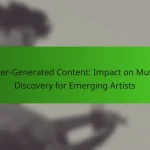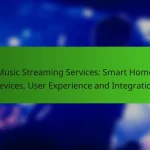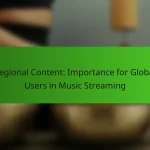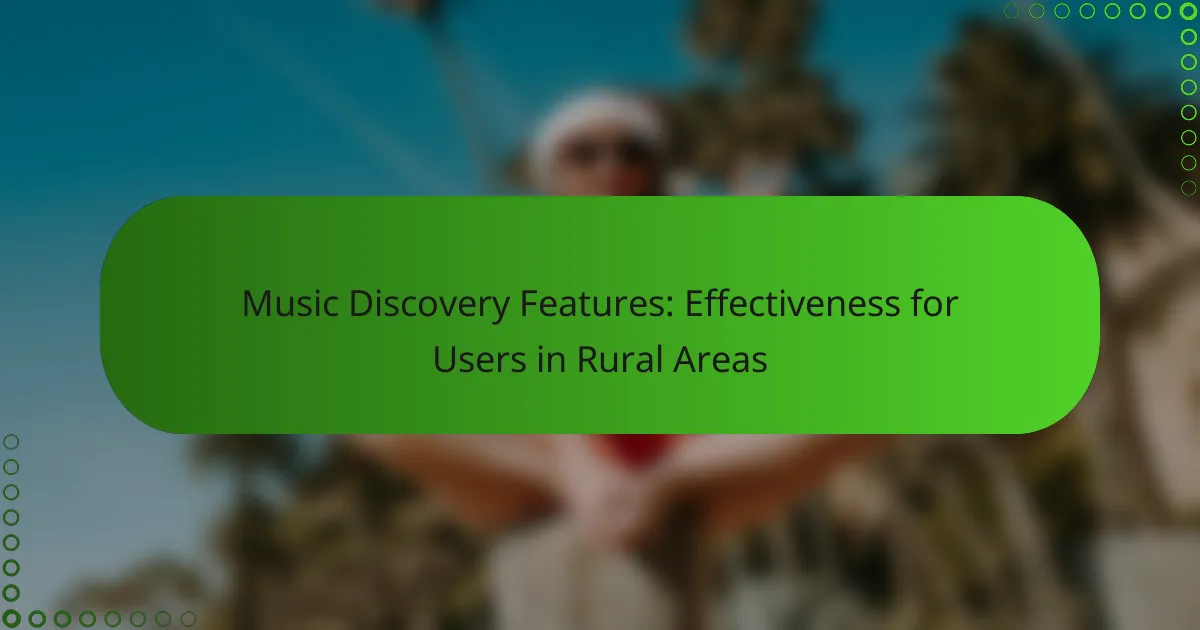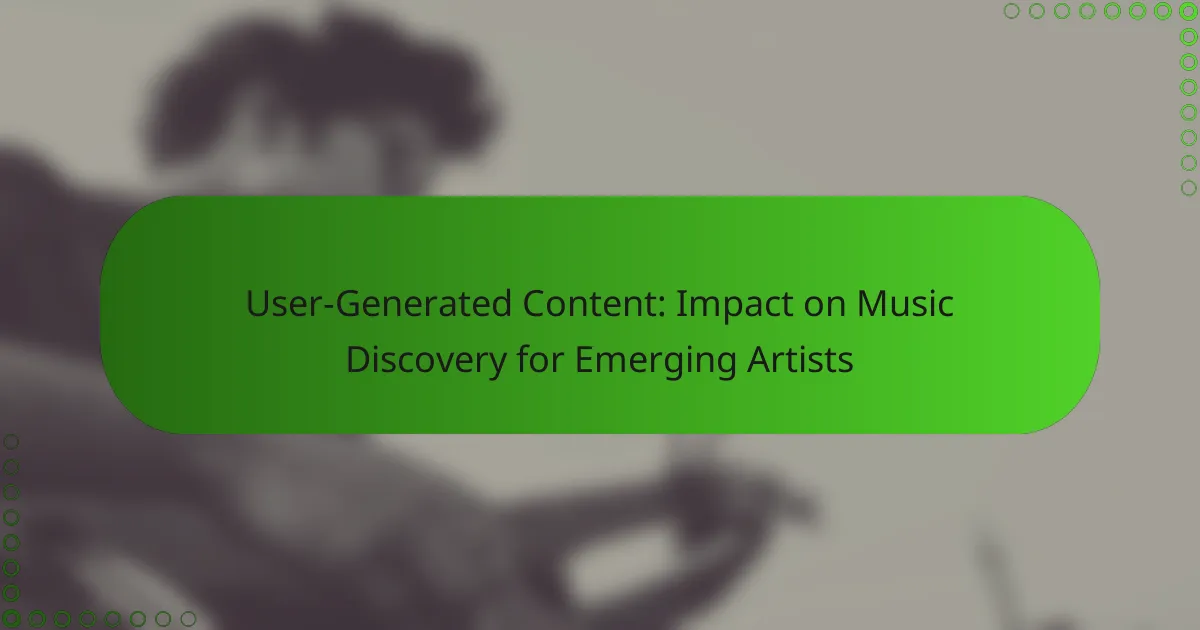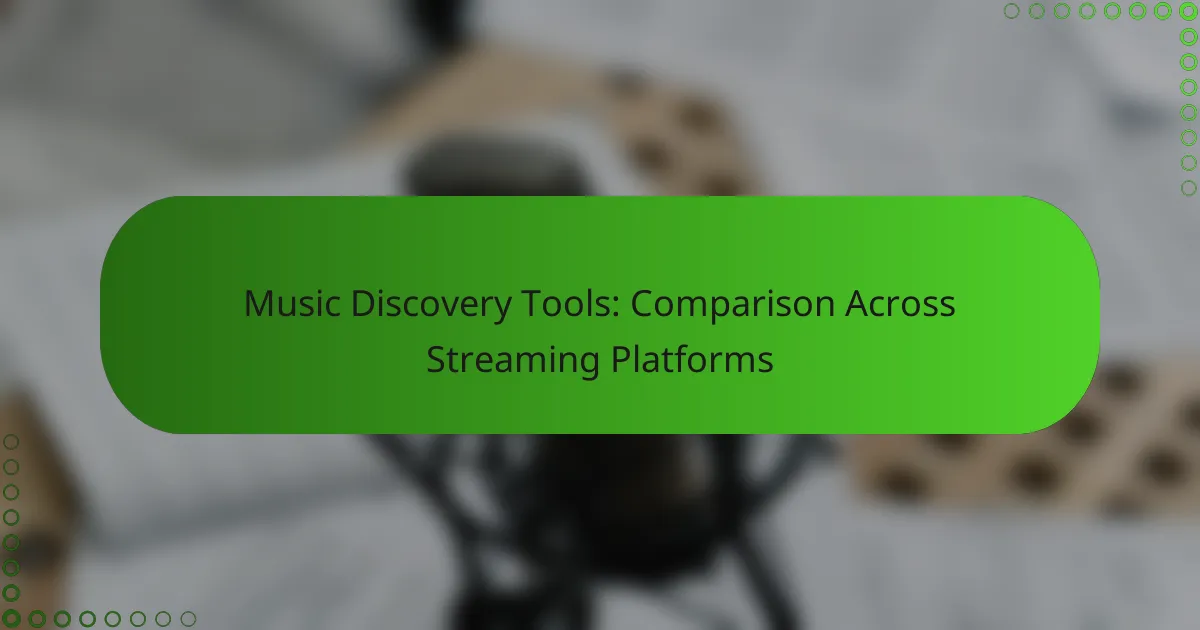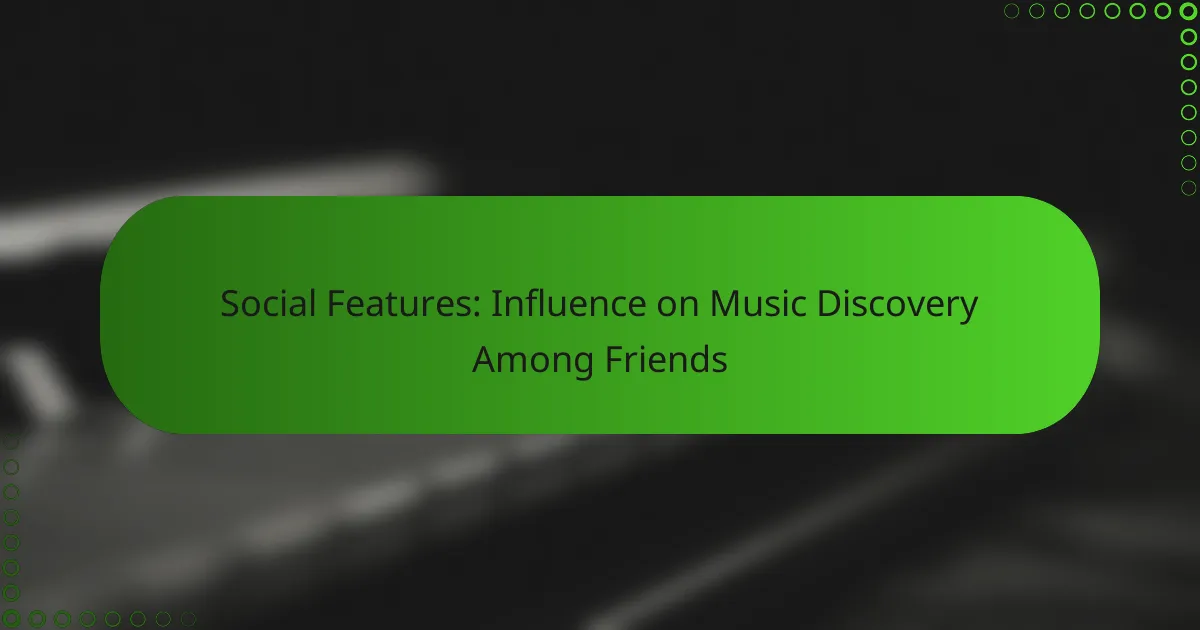Music discovery features play a crucial role in enhancing the listening experience for users in rural areas by broadening their access to diverse music and fostering community connections. Platforms like Spotify, Apple Music, and YouTube utilize algorithms and curated content to help users find new music that resonates with their tastes, even in regions with limited internet connectivity.
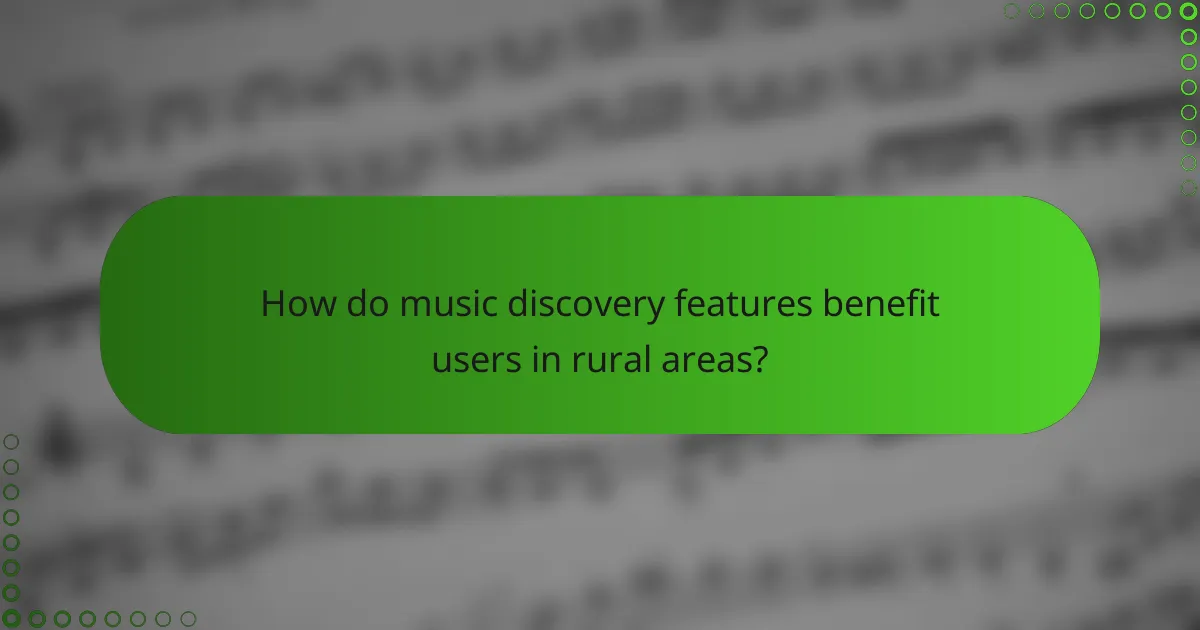
How do music discovery features benefit users in rural areas?
Music discovery features significantly enhance the experience for users in rural areas by providing access to a wider variety of music and fostering community connections. These tools help bridge the gap between local and global music scenes, making it easier for users to explore and engage with diverse sounds.
Increased access to diverse music
Users in rural areas often face limitations in music availability due to fewer local venues and radio stations. Music discovery features, such as algorithm-driven playlists and curated recommendations, allow these users to access a broader range of genres and artists from around the world. This exposure can lead to new musical interests and a richer listening experience.
Streaming platforms often utilize user data to suggest tracks that align with individual tastes, making it easier for rural users to find music that resonates with them. For example, a user might discover indie artists from different countries or explore niche genres that are not typically represented in their local music scene.
Enhanced community engagement
Music discovery features can foster a sense of community among users in rural areas by connecting them through shared musical interests. Online platforms often include social features that allow users to share playlists, attend virtual concerts, and discuss music with others, creating a virtual community space. This engagement can help combat feelings of isolation that may arise in rural settings.
Local music events can also be promoted through these platforms, encouraging users to participate in community gatherings and support local musicians. By engaging with music together, users can strengthen their social ties and build a more vibrant local culture.
Support for local artists
Music discovery features play a crucial role in promoting local artists who might otherwise struggle to gain visibility. By featuring local talent in playlists and recommendations, streaming services can help these artists reach wider audiences beyond their immediate geographic area. This exposure can lead to increased opportunities for performances and collaborations.
Rural artists can leverage social media and music platforms to share their work, connect with fans, and even sell merchandise directly. Users can support local musicians by attending shows, purchasing music, or sharing their favorite tracks with friends, thereby contributing to the sustainability of the local music scene.

What are the most effective music discovery platforms for rural users?
The most effective music discovery platforms for rural users include Spotify, Apple Music, and YouTube, each offering unique features that cater to different listening preferences and connectivity challenges. These platforms leverage algorithms and curated content to help users find new music that aligns with their tastes, even in areas with limited internet access.
Spotify’s personalized playlists
Spotify excels in providing personalized playlists such as Discover Weekly and Release Radar, which adapt to users’ listening habits. These playlists are updated regularly, making it easy for rural users to discover new artists and songs without needing to search extensively.
To maximize the effectiveness of Spotify’s recommendations, users should engage with the platform by liking songs and following artists. This interaction helps the algorithm refine its suggestions, ensuring a more tailored music experience over time.
Apple Music’s curated recommendations
Apple Music offers curated recommendations through its editorial team, which creates playlists based on genres, moods, and trends. This feature is particularly useful for rural users who may not have access to local music scenes or events.
Users can explore playlists like “Today’s Hits” or “Chill Mix” to discover new music. Additionally, Apple Music’s integration with Siri allows for hands-free music discovery, making it convenient for users in rural areas with limited screen time.
YouTube’s algorithm-driven suggestions
YouTube utilizes a powerful algorithm to suggest music videos based on users’ viewing history and preferences. This feature allows rural users to explore a wide range of music genres and discover emerging artists through recommended content.
To enhance music discovery on YouTube, users should create playlists and subscribe to channels that align with their interests. Engaging with content by liking and commenting can further improve the accuracy of the algorithm’s suggestions, leading to a richer music experience.
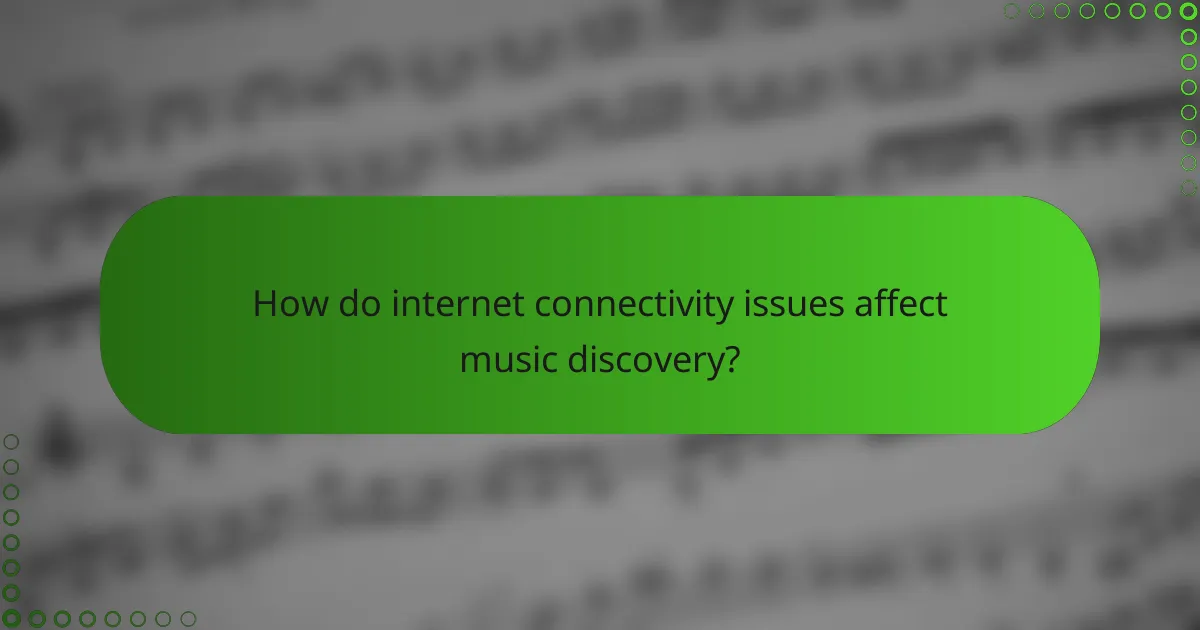
How do internet connectivity issues affect music discovery?
Internet connectivity issues can significantly hinder music discovery, especially in rural areas where access may be limited or unreliable. Slow or intermittent connections can restrict users from streaming music effectively, leading to a frustrating experience when trying to explore new artists and genres.
Limited streaming capabilities
In rural areas, users often face limited streaming capabilities due to poor internet infrastructure. This can result in lower audio quality, frequent buffering, and even complete inability to access certain platforms. Many music streaming services require a stable connection to function properly, which can be a challenge for those with slower internet speeds.
Users may find themselves relying on lower-quality audio formats or downloading music in advance, which can restrict their ability to discover new tracks in real-time. This limitation can lead to a less dynamic music discovery experience, as users miss out on trending songs and personalized recommendations that require consistent connectivity.
Impact on user experience
The impact of connectivity issues on user experience is profound, as frustrations can lead to decreased engagement with music platforms. Users may abandon apps that do not perform well, opting instead for offline solutions or traditional media like radio. This shift can limit exposure to new music and artists, ultimately stunting the discovery process.
Additionally, the inability to access curated playlists or social features can diminish the sense of community that many streaming services offer. Users in rural areas may miss out on collaborative playlists or local music events, further isolating them from the broader music culture.

What features improve music discovery in low-bandwidth areas?
Music discovery in low-bandwidth areas can be significantly enhanced through features like offline listening options and data-saving modes. These functionalities allow users to access and enjoy music without relying heavily on a stable internet connection.
Offline listening options
Offline listening options enable users to download music tracks or playlists for later playback without an internet connection. This is particularly useful in rural areas where connectivity may be inconsistent or limited. Many streaming services offer this feature, allowing users to store a selection of songs on their devices.
To make the most of offline listening, users should regularly update their downloaded content when they have access to a reliable internet connection. This ensures they have the latest music and can enjoy a diverse library without interruptions.
Data-saving modes
Data-saving modes help users minimize their data usage while streaming music. These modes often adjust the audio quality, reducing the amount of data consumed per track. For example, streaming at a lower bitrate can significantly decrease data usage, making it more feasible for users with limited bandwidth.
When using data-saving modes, users should consider their preferences for sound quality versus data consumption. Many services allow users to toggle these settings easily, enabling a balance between enjoying high-quality audio and conserving data, especially in rural settings where internet speeds may vary.
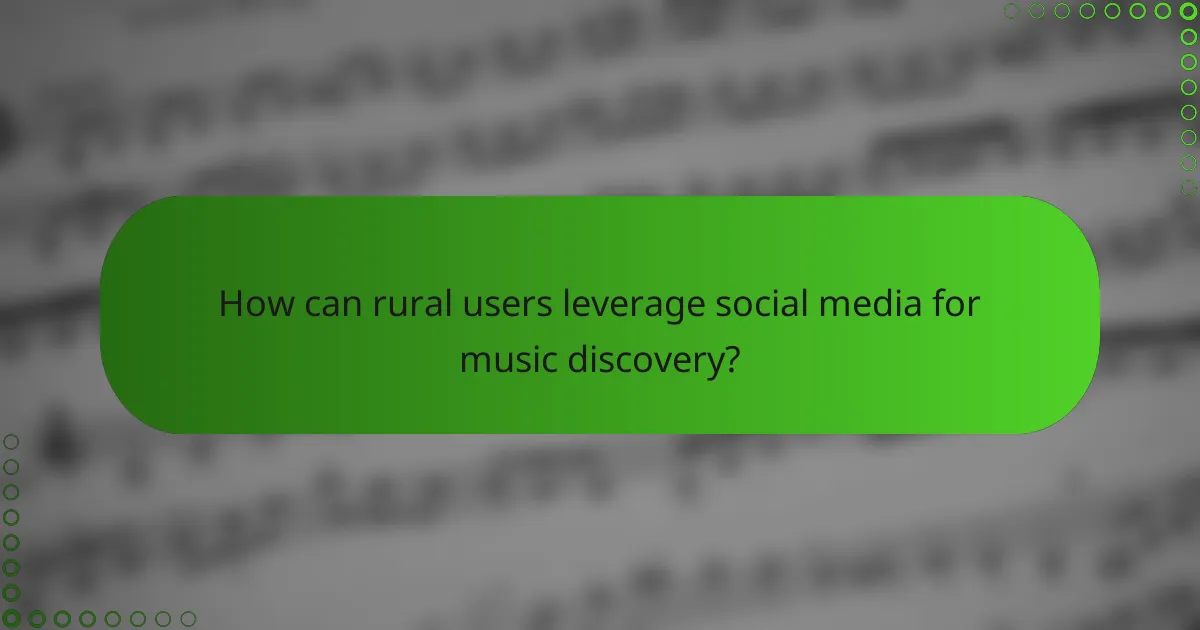
How can rural users leverage social media for music discovery?
Rural users can effectively utilize social media to discover new music by engaging with local communities and following artists. These platforms provide access to a wider range of music and connections that may not be available in their immediate surroundings.
Engaging with local music communities
Joining local music groups on platforms like Facebook or Reddit can help rural users connect with fellow music enthusiasts. These communities often share recommendations, upcoming events, and local artist highlights, creating a vibrant network for music discovery.
Users can actively participate by posting their own music preferences or asking for suggestions, which can lead to personalized recommendations. Attending local shows or virtual meet-ups organized through these groups can further enhance the experience.
Following artists on platforms like Instagram
By following artists on Instagram, rural users can gain insights into their favorite musicians’ latest releases and behind-the-scenes content. Many artists use social media to share new tracks, music videos, and personal stories that resonate with fans.
Additionally, users can discover similar artists through recommendations and collaborations showcased on these platforms. Engaging with posts through likes and comments can also foster a sense of community and connection with the music they love.
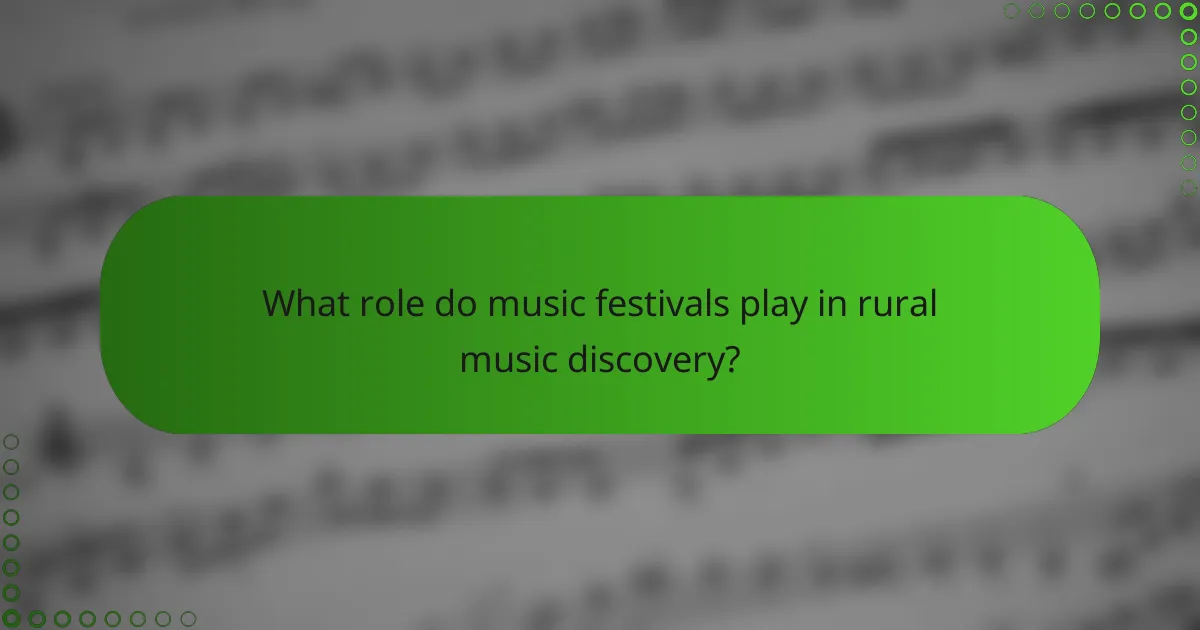
What role do music festivals play in rural music discovery?
Music festivals serve as vital platforms for music discovery in rural areas, connecting local artists with audiences and industry professionals. These events often highlight regional talent and foster community engagement, making them essential for promoting music in less populated regions.
Showcasing local talent
Music festivals provide an opportunity for local musicians to perform in front of larger audiences, which can significantly boost their visibility. By featuring a diverse range of genres, these festivals allow attendees to discover new artists they might not encounter otherwise.
For example, a small town festival might include folk, country, and indie rock acts, appealing to various musical tastes. This exposure can lead to increased local support and even opportunities for artists to collaborate with others in the industry.
Creating networking opportunities
Festivals facilitate connections between artists, producers, and music enthusiasts, which can be crucial for career development. Networking at these events can lead to collaborations, bookings, and mentorship opportunities that might not be available in rural settings.
Attendees can engage with industry professionals through workshops and panels, gaining insights into the music business. For aspiring musicians, these interactions can provide valuable guidance on navigating the complexities of the music industry.

How do user preferences vary in rural music discovery?
User preferences in rural music discovery often lean towards local genres and artists, influenced by cultural ties and community engagement. Access to music discovery tools may be limited, leading to a reliance on word-of-mouth and local radio stations.
Influence of Local Culture
In rural areas, music preferences are heavily shaped by local culture and traditions. Users may favor genres that reflect their heritage, such as folk, country, or regional styles. This cultural connection often drives the discovery of artists who resonate with community values and experiences.
Access to Technology
Access to technology can significantly impact music discovery in rural regions. Many users may have limited internet connectivity, which restricts their ability to use streaming services or music apps. Offline options, such as local radio or community events, become essential for discovering new music.
Community Engagement
Community engagement plays a crucial role in music discovery for rural users. Local events, such as festivals or concerts, provide opportunities for people to discover new artists and genres. Social gatherings often facilitate sharing music recommendations, enhancing the discovery process through personal connections.
Challenges in Music Discovery
Rural users face unique challenges in music discovery, including limited access to diverse music platforms and fewer recommendations from algorithms. This can result in a narrower exposure to different genres compared to urban users. To overcome these challenges, rural listeners can seek out local music groups or online communities that focus on regional music.
